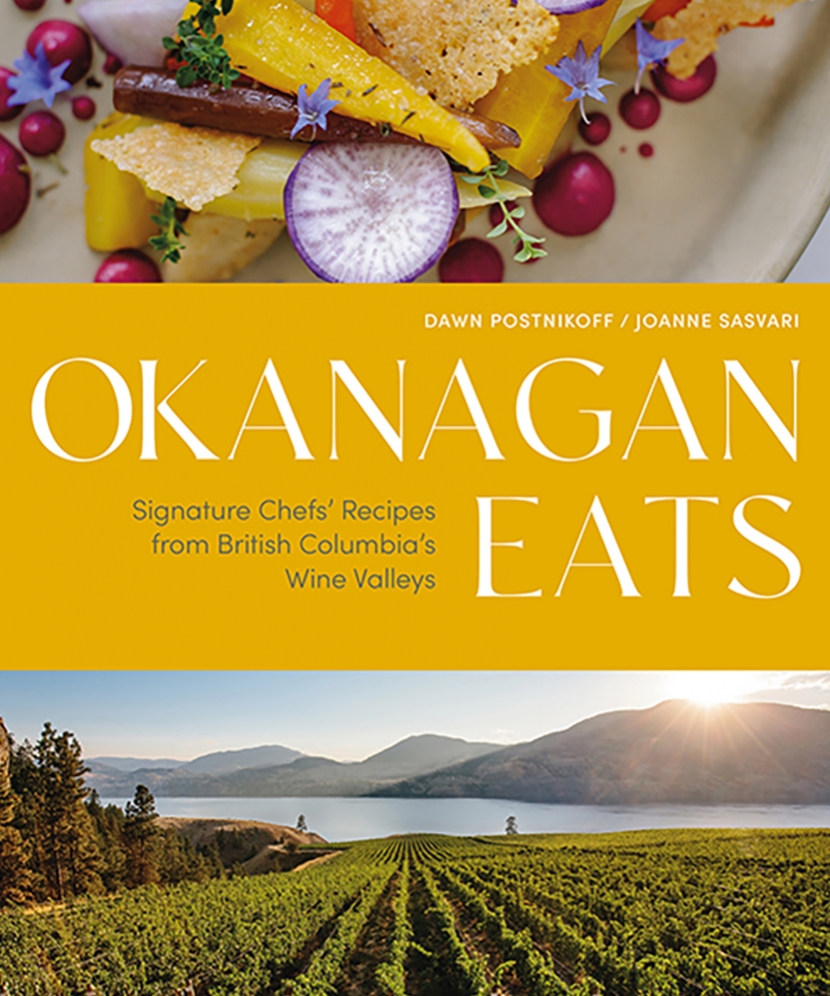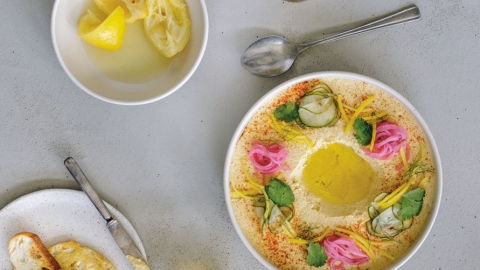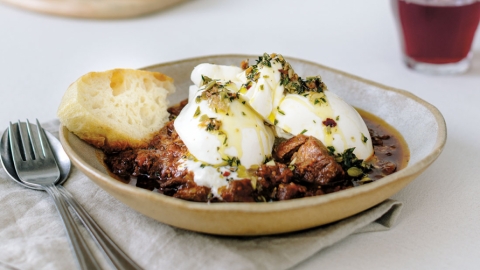Grazing Through the Okanagan
The summer of 2023 was a difficult one. So much was lost due to forest fires across British Columbia. The Okanagan in particular faced catastrophic losses that continue to have a lasting impact on the people, the environment and the economy. Now more than ever, local food and beverage businesses need people to visit the region and experience all that it has to offer. To help you plan your trip, Dawn Postnikoff and Joanne Sasvari, through their latest collaboration — Okanagan Eats, Signature Chefs’ Recipes from British Columbia’s Wine Valleys — offer up the perfect culinary travel guide.
With more than 70 signature recipes from 37 of the Okanagan’s best chefs, restaurants, cafés, bakeries, breweries, distilleries and wineries, Postnikoff and Sasvari (who also writes for edible Vancouver) invite you to learn more about the region and how to prepare its bounty. However, the book is also about the interesting businesses and talented people who call the Okanagan home. Their stories, beautifully woven throughout the book, along with their favourite recipes and local pairings, are a reminder of why the region is recognized worldwide and is worth visiting any time of the year.
Postnikoff and Sasvari were worried when they heard about the fires. So much so that they decided to donate a small portion of revenue from book sales to the local food bank. “When you do a book like this,” Sasvari says, “it becomes very personal because you just can’t help but think of the people you've gotten to know and like, and care about quite deeply, and wonder how they’re affected by this.”
As the book subtitle suggests, the Okanagan refers to the three valleys that make up the various wine regions: The Similkameen and Thompson River Valleys and the Okanagan Valley, which includes a series of lakes (including one that may or may not have its very own lake monster, the Ogopogo). It is a vast area with varied landscapes and climates, which affects the culinary culture.
“That could mean the cattle that graze the grasslands of the Thompson River Valley, the freshwater fish of the Shuswap, the organic tomatoes and peppers of the Similkameen, or the apples and apricots of the Okanagan.”
These regions are also experiencing a booming wine industry with craft breweries and distilleries not far behind. Seasonal cooking features strongly, but Sasvari talks about how this is taken a step further in the Okanagan with many restaurants focusing on micro-seasons — “those few short days when cherries or tomatoes or wild asparagus are at absolute peak ripeness, when their fragrance is intoxicating and when their flavour simply explodes on your tongue.”
Having written Island Eats together during the first year of Covid-19 restrictions, Postnikoff and Sasvari thought this book would be easier. However, it turns out that writing a cookbook during the second year of the pandemic was even more challenging.
“Things were constantly changing, businesses were struggling and there were still so many travel restrictions,” Sasvari says. Despite all of this, they were able to push through and are grateful for the times they were able to meet with people in person. Deciding whom to include in the book was also difficult, as they wanted to ensure that there was a good mix of contributors from across the region, and that they all provided accessible recipes.
“When doing these books, we are very conscientious that even though the recipes are chef recipes, the people making the recipes are not chefs, they are home cooks,” Sasvari says. “We worked very hard to encourage the chefs to give us home cook-friendly things that don't involve really esoteric tools and ingredients or really complicated techniques.” They also asked the chefs or owners to pair each recipe with a local wine, craft beer or cocktail.
Together the authors tested all the recipes, which was sometimes tough for Sasvari. “To be honest, one of the biggest challenges of these books is you have to test the recipe as it's written and I never follow a recipe as it’s written.” She did, however, and noticed two distinctive things that made this book different from Island Eats and Vancouver Eats, both books she wrote on her own.
“In the Okanagan,” Sasvari says, “what's really interesting is obviously the local produce. You get many recipes for peaches and tomatoes and all the things that grow there. But there's this real sense of grazing. Like you're going to sit down with your friends, open a bottle of wine and have a bunch of little delightful things to eat.”
This book sets itself apart by providing a detailed overview of the various wine regions. Sasvari, who is passionate and knowledgeable about wine, wanted to help people understand why the Okanagan wine industry is so distinctive. “Not only is it geologically fascinating,” she says, “the people are interesting and the influences are so unusual in the world of wine. It's basically like you're going from Germany down to the southern Rhône River all in one very small area.”
In terms of the recipes, it is important to read them all the way through before diving in. Even though Postnikoff and Sasvari have tested them, the recipes are from passionate chefs who believe in layering flavours and textures, which often involves several steps and many ingredients, some of which may be unfamiliar and hard to find for the average home cook. However, if you have the patience to follow them through and don’t mind the hunting and gathering process, it’s worth the effort.
Okanagan Eats captures the exciting culinary scene and offers a wonderful overview of so much of what the Okanagan has to off er and why it’s also home to such a diverse and ever-growing wine, craft beer and distillery industry. And, although some of the businesses may have changed and some of the chefs have since moved on, the book is an excellent guide to help you plan your next meal or culinary travel adventure.








